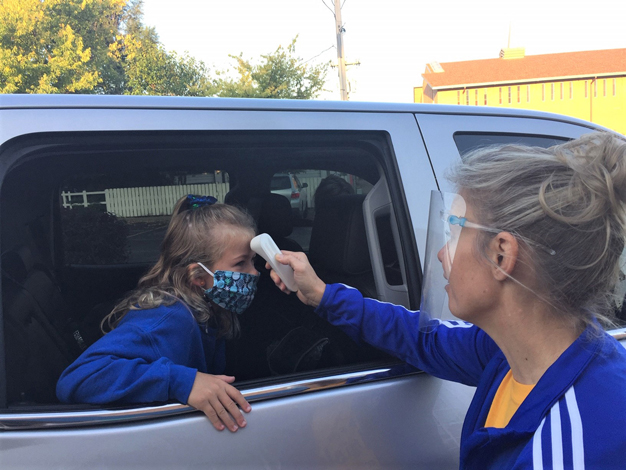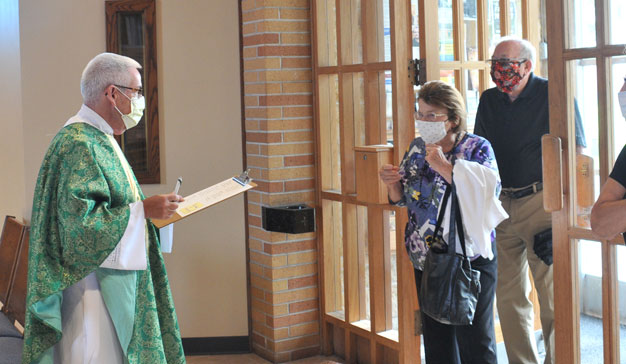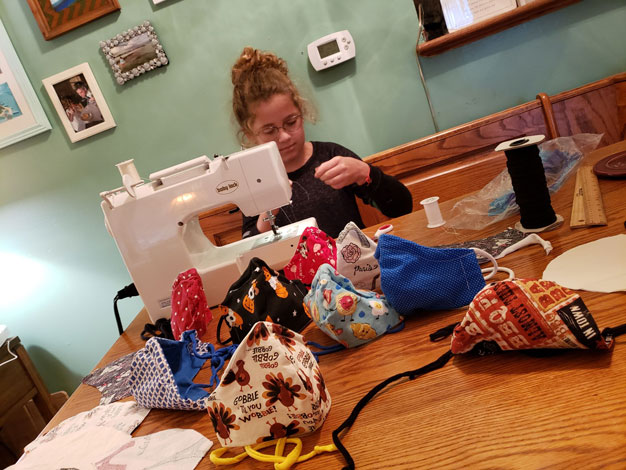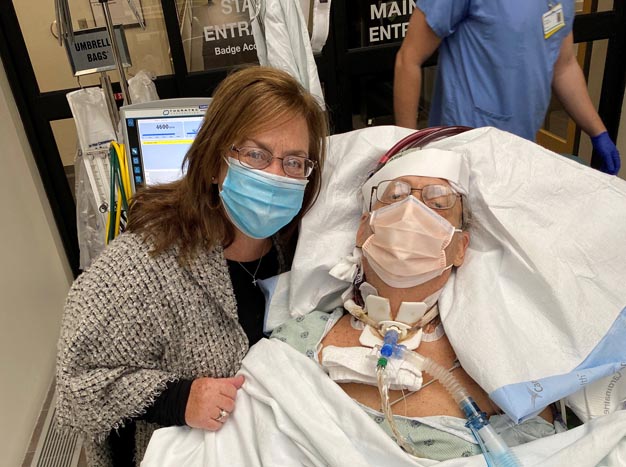
Roni and Rick Pianca of Our Lady of Victory Parish in Davenport, are pictured at Froedtert Hospital & Medical College of Wisconsin in Milwaukee, Wis. Rick was being treated for COVID-19 and passed away on Nov. 11.
By Barb Arland-Fye
The Catholic Messenger
“Faith over worry” became the go-to phrase of Roni Pianca of Davenport and her close-knit family as they journeyed through 94 days of her husband Rick’s fight with COVID-19. Rick succumbed to the vicious disease on Nov. 11, at 3 p.m., the hour of the day Roni prayed the rosary and the hour that Christ died on the cross, she notes.
Roni and her family, relatives and friends, never gave up hope for a miracle. Rick had been healthy, active and full of life before contracting coronavirus. They remember Rick, 62, as the life of the party, the caring guy who practiced hospitality par excellence.
The Catholic Messenger asked Roni to share her family’s experience of the COVID-19 pandemic that has claimed more than 265,000 lives nationwide and more than 2,426 in Iowa (coronavirus.iowa.gov.).
Focused on family and hospitality
First, we begin with the love story of Rick and Roni and the bonds they formed with family, friends, faith community, priests and the healthcare workers who dedicated their skills and compassion to a valiant effort to save Rick’s life.
“I met him on my 18th birthday. We’d been together ever since,” recalls Roni, 61, of their first encounter, at Uncle Sam’s, a long-ago nightclub in Davenport where Rick worked at the time. He was a year older than Roni. The couple married on June 30, 1979, at Our Lady of Victory Catholic Church in Davenport, the church that Roni’s grandfather helped build.
Rick and Roni honeymooned at Disney World, which became their favorite go-to destination with family and friends. Rick provided tips and tricks to family and friends on navigating Disney World to gain the maximum enjoyment. “Rick always wanted to make sure everybody had a good time,” Roni said. “Rick was the first one who would say, ‘Let’s go. Don’t wait for tomorrow.’”
Family man is perhaps the best descriptor for Rick. He and Roni raised two daughters, Rachel (married to Brian Gartner), 33, and Chelsey (married to John O’Donnell), 30. “We are very close with our kids,” says Roni. “We have two wonderful sons-in-law and two granddaughters. They were at our house on weekends. (Rick) would do the grocery shopping, the cooking and the cleanup. He loved to have all of us together.”
The Piancas have been active members of Our Lady of Victory Parish and its school, John F. Kennedy. Their daughters graduated from JFK and Assumption High School in Davenport. Rick and Roni helped start the committee that organized the annual fundraising gala for the parish and school.
They developed a lasting friendship with Father Apo Mpanda when he served as parochial vicar at Our Lady of Victory two decades ago. Father Apo prayed daily for the family as they endured their COVID-19 experience. “He and Rick had a special bond,” Roni said.
“Rick was a great friend who cherished our friendship,” Father Apo said. “He had a good sense of humor. He wanted to help anyone. He cared for people.” Roni recalls a humorous story involving Father Apo and Rick at the 60th wedding anniversary celebration of Rick’s parents, Richard and Betty Pianca. Every time Father Apo turned around to pick up his glass of wine, it was full. When he wondered how that happened, Rick quipped, “The good Lord did it again!” (Rick’s father died on Thanksgiving Day this year, two weeks after his son’s death).
Coronavirus journey
Employed in product support, sales and service for Altorfer Co., Rick worked from home during the pandemic. On Aug. 9, coughing and not feeling well, he visited an urgent care clinic where he was told he had a mild case of COVID-19 and that he should self-isolate at home.
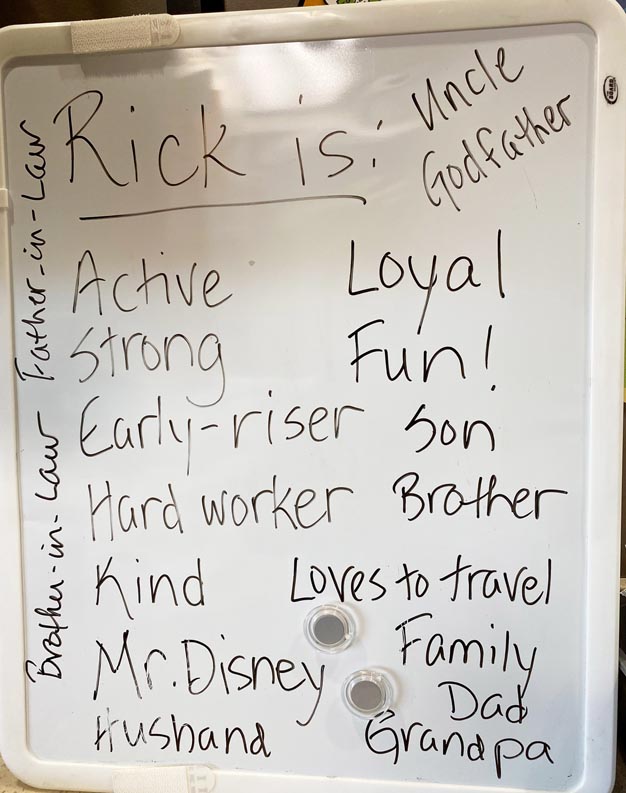
Roni Pianca wrote adjectives to describe her husband Rick so that hospital workers could know him a bit better.
“By Aug. 13, he was not getting better … I said, ‘Rick, I want you to call your doctor today,’” Roni recalled. After listening to his cough over the phone, the doctor advised Rick to go to the emergency room. Roni drove Rick to Genesis West in Davenport, but had to drop him off in the parking lot because of pandemic restrictions. Genesis did not have a bed available for Rick, so he traveled by ambulance to UnityPoint in Rock Island, Illinois. Roni followed the ambulance, but had to wait in the parking lot because of pandemic restrictions.
The healthcare providers and Rick kept her posted, Rick by text. “He was texting, ‘Don’t worry. They’re going to keep me a few days.’ But (his condition) went downhill quickly,” Roni said. Rick required a ventilator to help him breathe. Doctors treated him with plasma and Remdesivir and had him on a pronating bed to improve ventilation. His healthcare providers determined he needed advanced care at a larger hospital.
Rick and Roni’s niece, Jordyn Werderitch, a nurse practitioner at Froedtert Hospital & Medical College of Wisconsin in Milwaukee, called on a regular basis to get updates on Rick’s condition. When his lab test results continued to show a decline in his condition, she worked with doctors at her hospital to transfer him to Froedtert. Flight for Life Emergency Transport System flew Rick to Froedtert on Aug. 18.
“My uncle and I have always had a close relationship. He would greet me with a joke or an incredible story every time I saw him. He was one of a kind and the life of the party, but also a really caring guy too. I prayed and researched for him every single day of his hospital journey,” Jordyn said.
Upon his arrival at Froedtert, surgeons operated to provide Rick with a life-support option, Extracorporeal Membrane Oxygenation (ECMO) to oxygenate his blood. “He became ill so quickly,” Roni said. “That’s what is so unbelievable, because he was so alive.” He had no underlying medical conditions but contracted a lethal strain of the virus, she said.
For the first 21 days of his stay at Froedtert, Rick remained in isolation, meaning his family could not visit in person. He used the social media app “FaceTime” to visit with his kids. He had to have a tracheotomy and occasionally had a speaking valve. “They would put it on and take it off during speech therapy,” Roni said.
Most of the time, he couldn’t talk, and relied on physical gestures and an occasional written note to convey his thoughts. One message he wrote on a piece of paper, “Rick loves Roni.” “That was on his mind; he wanted to let me know,” Roni says tenderly. She wrote descriptive adjectives about her husband on a whiteboard in his hospital room to help his healthcare providers know about him.
Prayers, faith and togetherness
Even as his condition deteriorated, “He tried so hard doing his therapy,” Roni said. She expresses gratitude to all of the healthcare providers who cared for her husband at the hospitals where he fought for his life. Nurses who worked 12-hour shifts at Froedtert got to know and love Rick, she said. After Rick died, “I got a text from one of his nurses. She said she couldn’t stop thinking about Rick and us. She’s so sad Rick lost his battle.”
Roni stayed first at a hotel and then at Kathy’s House, a hospital guesthouse, during Rick’s hospitalization at Froedtert. She continued working remotely as vice president of relocation and business development for Ruhl&Ruhl Realtors. Her team and the company’s owners provided all the support she needed, she said.
Her pastor, Father Jake Greiner, along with Father Apo and other priests also provided moral and prayer support. “That’s what helped us on this journey,” Roni said. “Father Apo kept telling us, ‘I believe in miracles.’ We did, too.”
Rick died on the third wedding anniversary of his younger daughter and son-in-law. “We decided it will be a remembrance. We’ll celebrate his life every year on their anniversary,” Roni said.
“We will all miss him, but we all have so many fun and unforgettable memories to share of him,” his niece Jordyn said.
“We did everything here on earth we could to help him,” Roni reflected. “I really feel it was his time and there’s a better place. It’s so sad for us. We’re left without him but we remember him as the fun one who took care of all of us. He’s in a beautiful resting place at Mount Calvary. I just know he’s watching over us.”







